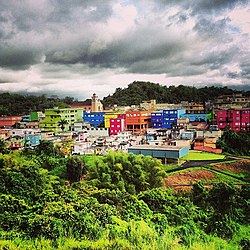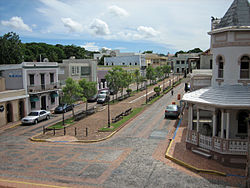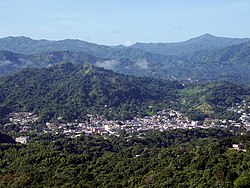Top Qs
Timeline
Chat
Perspective
Pueblos in Puerto Rico
Administrative, historic and cultural center of a municipality in Puerto Rico From Wikipedia, the free encyclopedia
Remove ads
Pueblo is a term primarily used in Puerto Rico to refer to the municipal district (barrio) that serves as the administrative, historic and cultural center of a municipality. The concept of pueblo is often used locally as analogous to the concept of downtown in U.S. cities.[1] Pueblos are officially called barrio-pueblo by the United States Census since 1990.[2]
Overview
Summarize
Perspective

The Spanish word pueblo[3] translates to 'town' in English, since many of these correspond to the original European-founded settlements in their respective contemporary municipalities; however, its usage in Puerto Rican Spanish today corresponds more closely to the concept of downtown in English.[4][5] In some cases, the concept of pueblo might also refer to municipality, but the term municipality never applies to pueblos.[1] With a few exceptions, the barrio-pueblo is also the historic district of the municipality and usually contains the main town square (plaza, and in some cases, plaza de armas) surrounded by the municipal administrative buildings (alcaldía) and the main Catholic church in town (either a cathedral or parish church).[2]
The central plaza or square, is a place for official and unofficial recreational events and a place where people can gather and socialize. The Laws of the Indies, the Spanish law which regulated life in Puerto Rico in the early 19th century, stated the plaza's purpose was for celebrations and festivities (Spanish: a propósito para las fiestas), most notably the town patron saint festivals (fiestas patronales), and that the square should be proportionally large enough for the number of neighbors (Spanish: grandeza proporcionada al número de vecinos). These Spanish regulations also stated that the streets nearby should be comfortable portals for passersby, protecting them from the elements: sun and rain.[6]
As of the 2010 census, Mayagüez is the most populated pueblo in Puerto Rico with a population of 26,903, while Las Marías has the lowest population with 262 inhabitants. The largest barrio-pueblo in Puerto Rico is Fajardo with a total area of 3.23 square miles, while Toa Alta is the smallest with an area of 0.03 square miles.[7]
Exceptions
Although all barrio-pueblos correspond to the administrative and downtown area of Puerto Rican municipalities, some barrios and clusters of barrios (such as in Ponce) also function and are categorized as the pueblos of their respective municipalities. The municipality of San Juan is a good example of this: the barrios Pueblo and San Juan Antiguo correspond to the pueblos of the former municipalities of Río Piedras and San Juan (pre-1951). Both of these contained a main town square or plaza de armas with a city hall and a church. When San Juan and Río Piedras merged into a single municipality in 1951, the former pueblo of Río Piedras retained its name.[8] Florida and Ponce are the two other municipalities in Puerto Rico that do not contain a designated barrio-pueblo. The exception of Florida is due to the fact that the municipality has no barrios,[9] while Ponce does not have a single designated barrio-pueblo but six barrios that correspond to the pueblo of Ponce.[10][11]
The name of the pueblo almost always is the name as the municipality is located in. For example, the barrio-pueblo of the municipality of Caguas is also called Caguas (Pueblo de Caguas). The exception to this occurs with the island municipalities of Culebra and Vieques. Although the barrio-pueblo of Culebra is known as Culebra (Pueblo de Culebra) today, its former name used to be Dewey,[12] while the name of the barrio-pueblo of Vieques today remains Isabel II.[13] Both of these are also the main settlements of the islands they are located in.
Remove ads
History

Although the urban zones that today are designated as barrio-pueblo have existed since the Spanish colonization of Puerto Rico, the concept of barrio was first used in the island during the 19th century. Historians have speculated the creation of barrios as administrative units may have been related to the Puerto Rican representation at the Cortes of Cádiz.[14] All municipalities in the island had a distinct barrio officially called pueblo (this is where the contemporary usage of pueblo in Puerto Rico comes from). Many of these pueblos used to have a certain degree of autonomy and local governance in the form of councils. Today barrios and barrio-pueblos have no political autonomy, and their designation is now for statistical and municipal management purposes. In 1980, they were still referred to as pueblos on the US Census.[15] Beginning with the 1990 census, these pueblos have been officially referred to as barrio-pueblos by the United States Census Bureau.[2]
Remove ads
List of Pueblos
Summarize
Perspective
The following list includes all barrio-pueblos and equivalent barrios in Puerto Rico.[16][17][18] The municipality of Florida is not included in the list as it has no barrios nor barrio-pueblos.[9] Ponce today has no official barrio-pueblo designations, however six of its barrios (all given cardinal names, i.e., 'first', 'second', 'sixth') correspond to the original core equivalent to the concept of barrio-pueblo today.[10][11] The municipality of San Juan today, originally consisted of two separate municipalities with a barrio-pueblo each: San Juan Antiguo for the municipality of San Juan, and Pueblo for the former municipality of Río Piedras.[8]
1Barceloneta's main Catholic church is not located in the main town square because the present square was established in 1910 after the abolition of the Law of the Indies in Puerto Rico, and it has the distinction of being one of the few towns in Puerto Rico where the main church in front of the plaza is a Protestant (Pentecostal) rather than a Catholic church.[19]
2Culebra's main Catholic church is no longer located in front of the main town square.[20]
3Although the modern town of Guánica was founded in 1914, after the abolition of the Law of the Indies, its square, city hall and church were planned and built following the law's traditional urban planning parameters.[21]
4Ponce consolidated barrio-pueblo statistics include barrios Primero, Segundo, Tercero, Cuarto, Quinto, and Sexto.[22]
5Río Piedras was founded as a town and independent municipality in 1714 and despite being merged with the municipality of San Juan in 1951, it still preserves is main town square, church and former city hall building as established by the urban planning parameters of the Law of the Indies.[23]
6The cathedral was built in 1535, before the establishment of the Law of the Indies (1573) and therefore not located in the main town square of the city.[24][25]
7Santa Isabel's town square holds the distinction of being the first town plaza in Puerto Rico to host a purpose-built Protestant church (United Evangelical Church of Santa Isabel) in front of it.[26]
Remove ads
In pop culture
- The song "Me voy pa'l pueblo" by El Trío Los Panchos sings of going to the pueblo.[27]
Gallery
- Aguadilla Pueblo and its harbor.
- Plaza or main town square of the Arecibo Pueblo.
- View of Barranquitas Pueblo from PR-152 (2013).
- Historic architecture in Caguas Pueblo.
- Cayey Pueblo from PR-52.
- Coamo Pueblo, the third oldest settlement in Puerto Rico.
- Typical street scene in Culebra Pueblo (Dewey).
- Casa Cautiño in Guayama Pueblo. Pueblos often contain rich architectural, cultural and historic heritage.
- Humacao Pueblo skyline from the new city hall.
- Mayagüez Pueblo is the most populated barrio-pueblo of Puerto Rico.
- Ponce Pueblo from Cerro El Vigía.
- Historic house in Sabana Grande Pueblo.
- San Germán Pueblo is the second oldest settlement in Puerto Rico, and a designated National Historic District.
- Although no longer a municipality, Río Piedras Pueblo still stands in the modern-day municipality of San Juan.
- Eclectic architecture in Santa Isabel Pueblo.
- View of Utuado Pueblo.
- City hall of the island-municipality of Vieques at the Isabel II Pueblo.
- Public art at Yauco Pueblo.
Remove ads
See also
References
Wikiwand - on
Seamless Wikipedia browsing. On steroids.
Remove ads


















